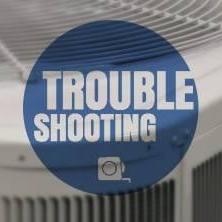Why Is One Room In My House So Cold/Hot?
If you’ve always had that one room in your home that’s noticeably hotter or colder than all the other rooms, check for:
- Closed vents
- Heat loss/gain via windows
- Unbalanced HVAC system
The good news is that you can solve the first 2 problems on your own. Unfortunately, though, you’ll need a professional to fix an unbalanced HVAC system.
Not sure exactly why you have one room that’s always so cold or hot? Don’t worry, we’ll show you how to troubleshoot this issue.
Need an HVAC pro to find and fix the problem? Just contact us.
Step 1: Check for closed vents in that room
Put simply, closed vents stop conditioned air from reaching that room, which will eventually cause that room to be hotter or colder than others (depending on the season).
Yeah, seems like a no-brainer, right? But you’d be surprised how many homeowners are guilty of closing vents throughout their home because they think it saves them money on heating/cooling bills.
In fact, we ran across so many homeowners who believed this HVAC myth that we wrote a blog explaining how closing vents actually increases energy bills, harms your HVAC system and leaves you uncomfortable.
What to do: Look for all the supply vents (seen below) in that room. Make sure that you always leave them open.

Is that room still hotter/colder than others even after checking the vents? Then continue on to step 2…
Step 2: Check for heat loss/gain via windows
According to a study by Penn State, windows lose more heat in the winter and gain more heat in the summer than any other surface in the home.
Two ways windows let in (or out) heat include:
- Through leaks
- Through the glass
What to do:
- For leaky windows:
First, check all of the windows and doors in that room for air leakage. You can use Energy.gov’s DIY air leak detection methods or have a professional check your room/home for air leakage.
If you or a professional find that the windows/doors in that room are leaky, use caulk, foam sealant or other weatherstripping methods to seal off the leaks. If you’re not up for the DIY air sealing route, have a professional air seal the problem areas.
- For heat loss/gain via glass:
Use blinds and drapes to cover the glass and keep the heat loss/gain at a minimum. For extra help, try using velcro strips to seal the drapes at both sides and overlap the drapes at the center. According to Energy.gov, this can cut heat loss/gain by up to 25%.
We also suggest having a professional inspect your windows and determine if you should upgrade to more energy efficient windows.
Step 3: Check for an unbalanced HVAC system (or leaky ducts)
If you have an “unbalanced” HVAC system, it means that not every room in your home is getting its fair share of conditioned air flow.
Most likely, this problem was caused by faulty installation or flaws in the design of the HVAC system.
More specifically, problems that cause an unbalanced system include:
- Not enough (or too many) vents in certain rooms
- Ductwork that needs to be insulated
- Long duct runs
- Vents that are not placed optimally
- A cooling/heating system that is undersized or oversized
- Home additions or renovations
- Ductwork that wasn’t sized correctly
What to do: Have a professional inspect and “balance” your HVAC system.
One room still colder/hotter than the rest? Get help from an AZ tech
If you’re still noticing the problem and aren’t sure why, just contact us.
We can send over a tech that will inspect your HVAC system, find the problem and offer professional solutions.

Justin Stevens is a 17-year veteran of the trades and one of the masterminds behind George Brazil’s world-class training lab for technical expertise and sales training. Justin has held several titles during his tenure at George Brazil ranging from Lead Installer and Installation Manager to QA Manager and Field Operations Manager. Today, Justin is the Director of Field Operations and plays a pivotal role overseeing all of George Brazil’s field departments.


